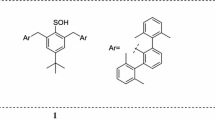Abstract
The reactivity of Br− and Cl− with triplet of anionic 6-chloropicolinic acid (pH = 5.4) and with triplets of 6-chloro and 6-bromopicolinic acids in zwitterionic forms (pH = 0.9) was studied by laser flash photolysis and steady-state irradiation. Br− was found to trap the three triplets. Triplet lifetime measurements gave quenching rate constants of 8 × 108 mol−1 dm3 s−1 for the zwitterion of 6-chloropicolinic acid and of 3.4 × 105 mol−1 dm3 s−1 for the anionic counterpart. No secondary transient species were observed indicating that the charge transfer intermediates are subject to dissipative processes. Cl− trapped triplet of zwitterions only, and reactions were found to be associated with a high quantum yield of radicals. The photolysis of 6-bromopicolinic acid photolysis was drastically enhanced by Cl−, 6-chloropicolinic acid being produced with a chemical yield of about 90%. The 6-bromo-2-carboxypyridinyl radical could be characterized (λmax/nm = 318 with shoulder at 370 nm and ε/mol−1 dm3 cm−1 = 8100).
Similar content being viewed by others
References
M. Anbar, and J. K. Thomas, Pulse radiolysis studies of aqueous sodium chloride solutions, J. Phys. Chem., 1964, 68(12), 3829–3835.
J. C. Scaiano, M. Barra, G. Calabrese, and R. Sinta, Photochemistry of 1,2-dibromoethane in solution. A model for the generation of hydrogen bromide, J. Chem. Soc., Chem. Commun., 1992, 1418–1419.
G. G. Jayson, B. J. Parsons, and A. J. Swallow, Simple, highly reactive, inorganic chlorine derivatives in aqueous solution. Formation using pulses of radiation and their role in the mechanism of the Fricke dosimeter, J. Chem. Soc., Faraday Trans. 1, 1973, 69(9), 1597–1607.
L. I. Grossweiner, and M. S. Matheson, The kinetics of the dihalide ions from the flash photolysis of aqueous alkali halide solutions, J. Phys. Chem., 1957, 61, 1089–1095.
G. Bartocci, and G. Favaro, Excited state reactivity of azaaromatics. VII: production and quenching of triplet naphthylpyridylethylene induced by halide anions, J. Photochem., 1979, 11(2), 79–86.
H. Shizuka, M. Nakamura, and T. Morita, Anion-induced fluorescence quenching of aromatic molecules, J. Phys. Chem., 1980, 84, 989–994.
A. Treinin, and E. Hayon, Quenching of triplet states by inorganic ions. Energy transfer and charge transfer mechanisms, J. Am. Chem. Soc., 1976, 98(13), 3884–3891.
J. K. Hurley, H. Linschitz, and A. Treinin, Interaction of halide and pseudohalide ions with triplet benzophenone-4-carboxylate: kinetics and radical yields, J. Phys. Chem., 1988, 92, 5151–5159.
F. Rollet, C. Richard, and J. F. Pilichowski, Photochemistry of 6-chloro and 6-bromopicolinic acids in water. Heterolytic vs. homolytic photodehalogenation, Photochem. Photobiol. Sci., 2006, 5, 88–94.
Calculated using Advanced Chemistry Development (ACD/Labo) software Solaris V4.67, 1994–2005, data base of Chemical Abstracts Service
F. Bonnichon, and C. Richard, Phototransformation of 3-hydroxybenzonitrile in water, J. Photochem. Photobiol., A, 1998, 119, 25–32.
G. Grabner, personal communication.
G. R. Dey, D. B. Naik, K. Kishore, and P. N. Moorthy, Reactions of hydrated electron, atomic hydrogen, and hydroxyl radical with picolinic acid studied by pulse radiolysis, J. Radioanal. Nucl. Chem., 1992, 163(2), 391–400.
S. Solar, W. Solar, N. Getoff, J. Holeman, and K. Sehested, Reactivity of atomic hydrogen, hydroxyl radicals, and solvated electrons with nicotinic acid: a pulse radiolysis study, Radiat. Phys. Chem., 1988, 32, 585–592.
G. G. Wubbels, E. J. Snyder, and E. B. Coughlin, HCl-catalyzed photoreduction of 4-bromonitrobenzene as a concomitant of nucleophilic aromatic photosubstitution involving radical intermediates, J. Am. Chem. Soc., 1988, 110, 2543–2548.
Author information
Authors and Affiliations
Corresponding author
Rights and permissions
About this article
Cite this article
Rollet, F., Richard, C. Reactivity of halides with triplets of 6-chloro and 6-bromopicolinic acids: contrasting effects of bromide and chloride. Photochem Photobiol Sci 5, 674–679 (2006). https://doi.org/10.1039/b601319h
Received:
Accepted:
Published:
Issue Date:
DOI: https://doi.org/10.1039/b601319h




